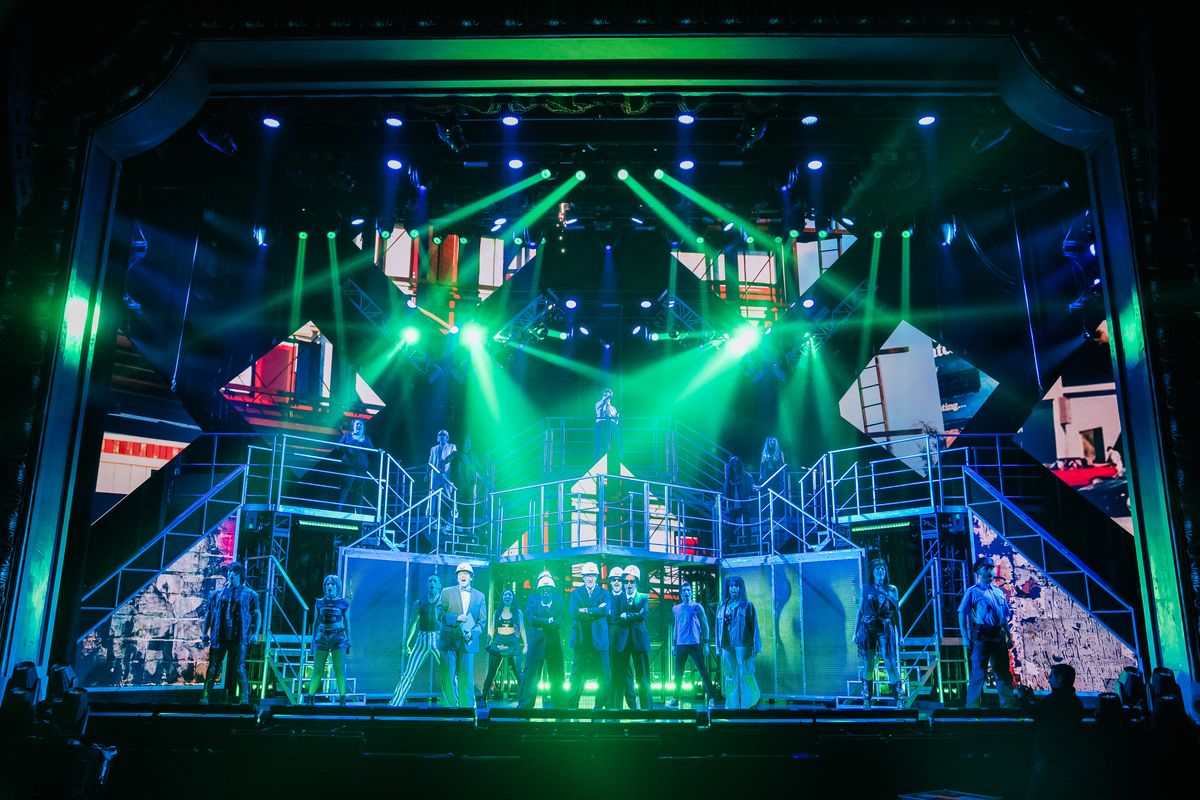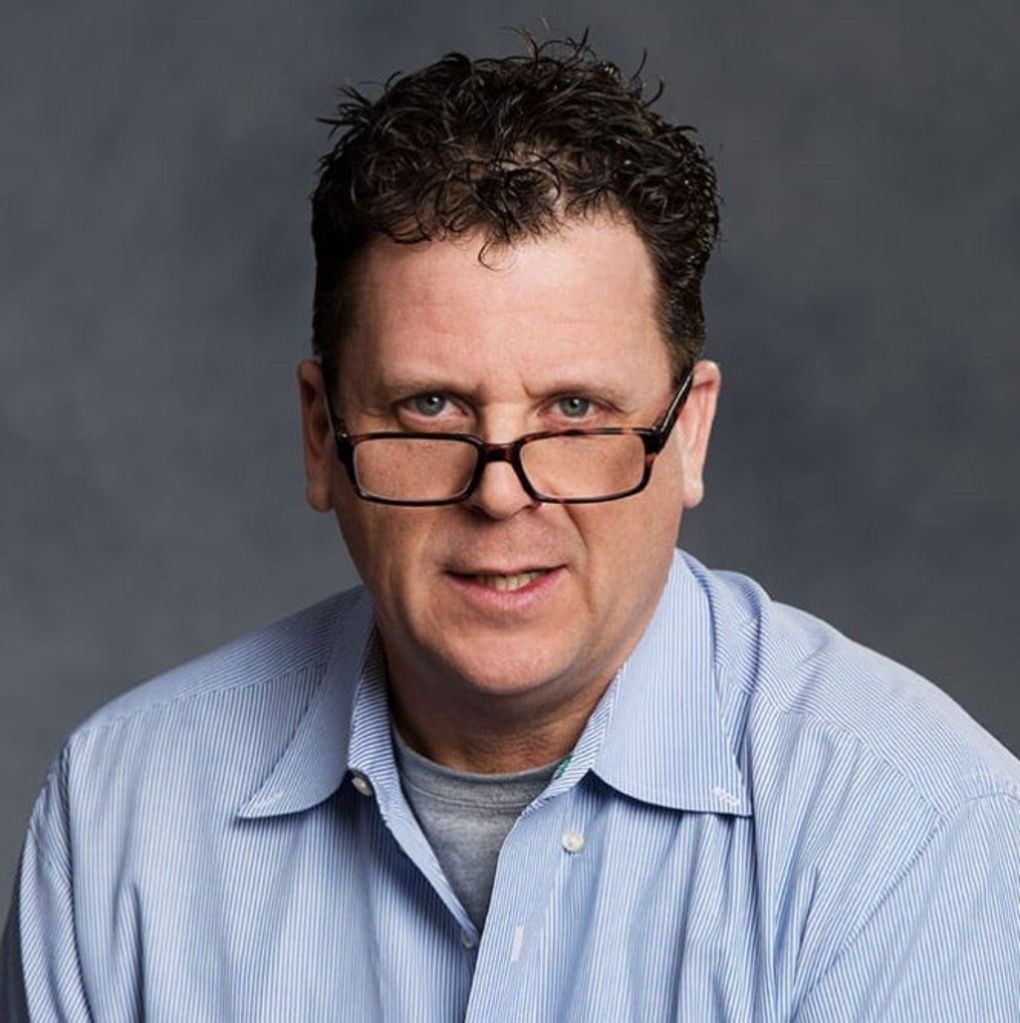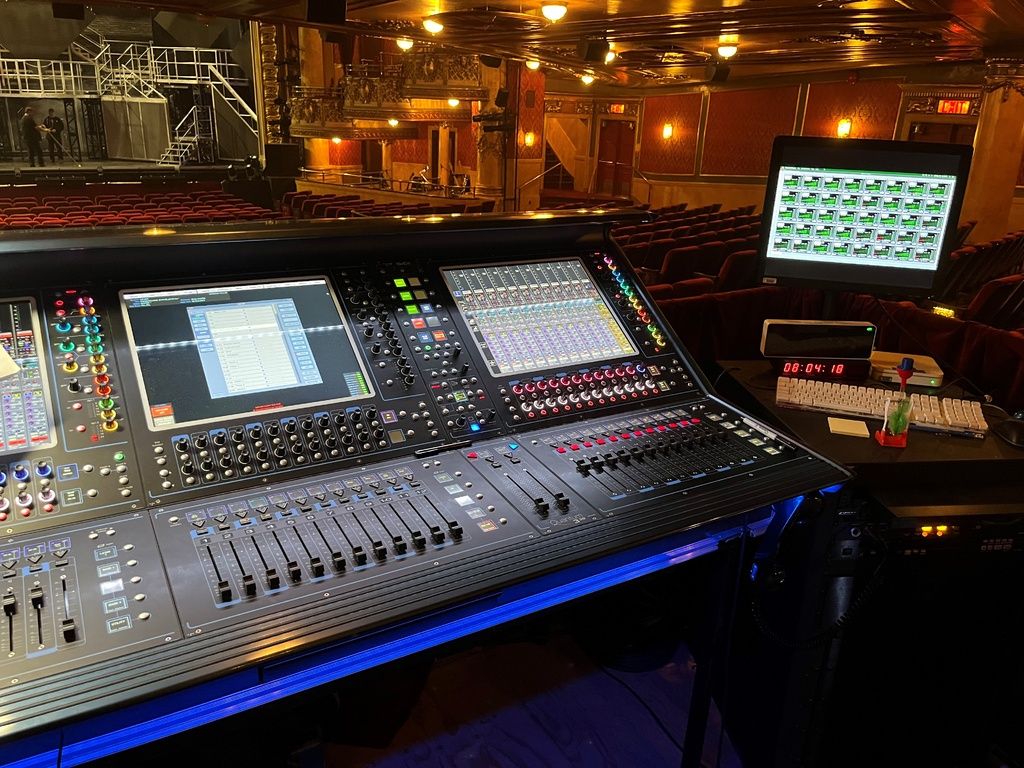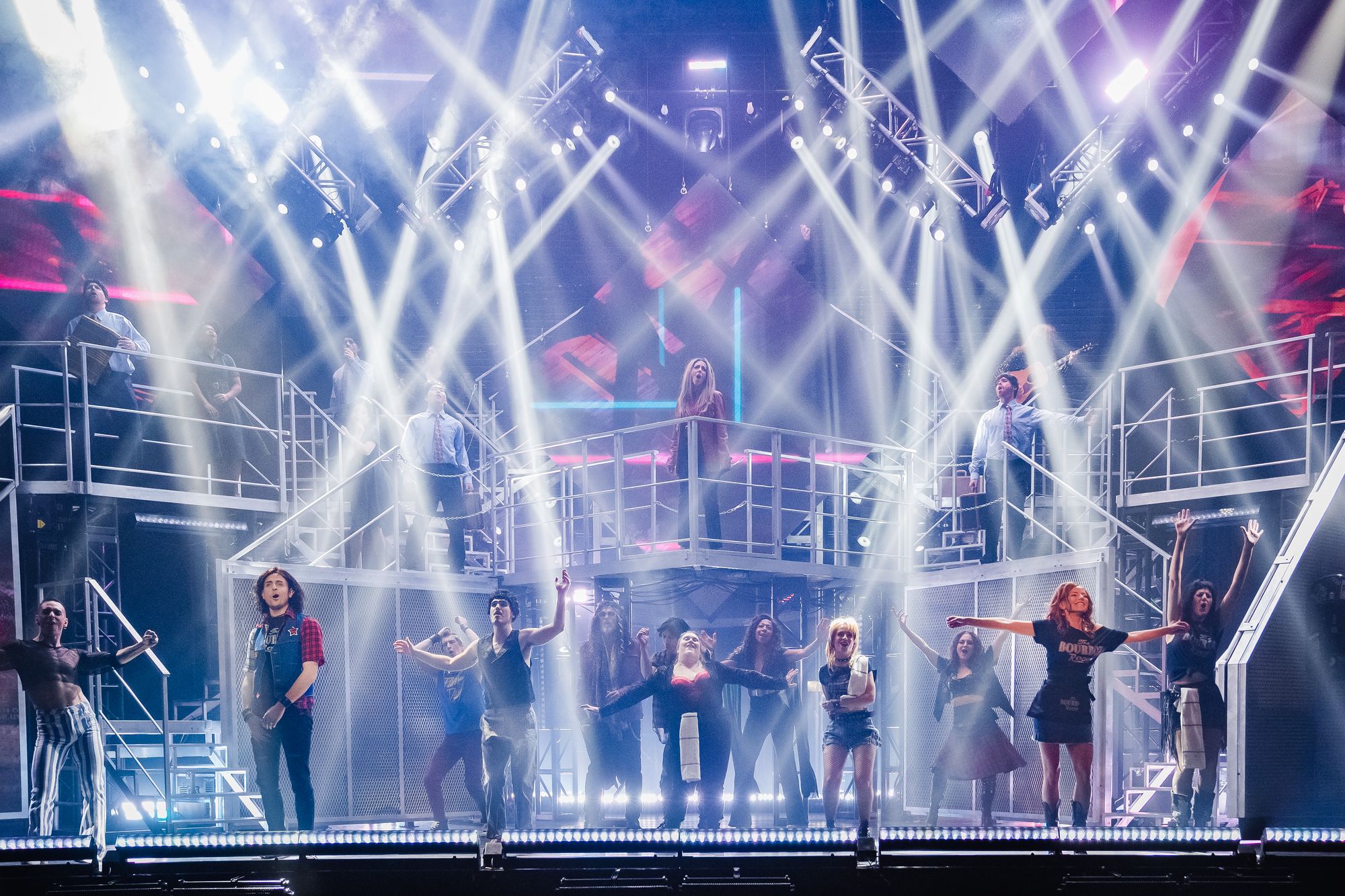The Spectacle and Intimacy of Rock of Ages

By Matt Bauer
Rock of Ages is the definitive jukebox musical. Originating on Broadway, it opened at Toronto’s Elgin Theatre on February 23, 2023 and played through May 20. It has all the rock ’n’ roll staples: boy meets girl and earnest musicians versus greedy business villains, all set to a roster of 1980s hits from the likes of Poison, Whitesnake, Starship, Foreigner, and others, played by a live band onstage. Long before the opening night curtain rose, it fell to sound designer John Lott to assemble a sound system that could handle lightning-speed changes and extreme dynamic range.
Lott, who cut his teeth with several Andrew Lloyd Webber productions, found himself in a career as a live theatre sound designer after graduating early from high school. “I went to theatre school to kill some time before I felt I was grown-up enough to attend university — and I never left!” he explains to us. “I started working in the theatre industry at 20. In the early ’90s, sound designers were really a new concept; Mega-musicals were also new. I lucked into a job working on Forever Plaid, which was supposed to be a five-week run and turned into four years. After that, I was introduced to a whole bunch of great folks, including Martin Levan, who was the original sound designer for Andrew Lloyd Webber. Back then he was sometimes looked at like he was eclectic because he did such unorthodox things, a lot of which have since become standard practice in musicals. He had a major influence on how consoles are used to manipulate massive sonic changes in real time. I had the good fortune to work as Martin’s third assistant, then second, then associate, then he left the business. I was lucky enough to know Richie Fitzgerald, one of the brothers who own Sound Associates. I worked alongside him for quite some time. There’s not a huge industry in Canada so I was able to get a lot of the work.”

Representing New York-based Sound Associates (which is a go-to sound company for Broadway) in Canada, Lott is also the resident sound designer at the Shaw Festival at Niagara-on-the-Lake, ON. He admits that getting the production up and running was a whirlwind. “It was being put on by a brand-new production company called More Entertainment, and while I don’t want to say they had deep pockets, they were prepared to spend some money to get it right,” he says. “The size of the project was overwhelming, and the show kept getting bigger because we kept adding more and more elements. It was fun, though, especially considering that Sound Associates worked the Toronto run of the show in 2010. The content is still equally entertaining to fans of this music, who are now in their 40s, 50s, and even 60s.”
Lott notes that balancing the spectacle and flamboyance of 1980s rock with the intimacy of traditional musical theatre posed a challenge. “I'm sort of old school music theatre,” he confesses. “And [Executive Producer and Director ] JP Gedeon was coming from a ‘Let's break all the rules’ kind of direction which is fine, except that some rules aren’t meant to be broken or in an attempt to break them you either spend lots of money or you attempt and then have to go back [laughs]. The biggest challenge for us really was the giant rock and roll PA that also had to be musical theatre in its presentation. Because we had to be able to do screaming and thrashing guitars, yet still have an intimate love scene between Drew and Sherry (the two ingénues). What I hate is when I go see a musical and it feels like the dialogue is in your face and comes from the PA because if that's the case, I might as well go to a rock concert because there's nothing intimate about it. So for us, the challenge was rocking tunes and the quiet intimate moments that happen from one second to the next.”

Prompted for the results, Lott feels a perfect balance was struck. “One of the things the director didn't want were booms which I was kind of thrilled about. But it meant we had to work really hard to get the head mics to have enough presence. One of the numbers that the lead character Drew sings is “I Wanna Rock” and of course, it happens in the middle of the bar, but it starts as a little intimate discussion between Drew and Sherry. And she's asking ‘What is it you really want to do?’ ’How do you want to spend your life?’ Then it goes from this quiet, simple conversation to pyro and backup dancers and the whole shebang. It was great. I thought we did a really great job.”
For all things wireless, Lott chose Lectrosonics. The 42-channel-plus system included a host of SSM micro belt-pack transmitters on most cast members and LT transmitters on guitars, Venue and Venue2 receiver frames with VRT and VRT2 modules, and the flexible Aspen DSP audio processing system serving as a monitor matrix.
Since the show uses over 400 moving lights complete with motors and fans, Lott says it was also a challenge not picking up that noise while putting omnidirectional mics on people’s heads to get their voices at 100dB or 110dB.
“We used DPA 4061 mics with SSM transmitters,” he says. “Usually, the mics are affixed just above the eyebrow. Everyone who sings is wearing a radio mic. I think maybe a couple of dancers who don’t have speaking parts are mic-less, but that’s it.”
“There are 42 channels of Lectro on the talent, plus two handheld mics, plus four sets of in-ear monitors, and then six channels of wireless comms,” he adds. “Six of the principal cast wear doubles, which we run on separate receiver racks in the very unlikely event that a power supply for a rack were to go down. So, it’s pretty saturated. Plus, the Elgin Theatre in Toronto is a double-stacked venue, which is a theater design from the Edwardian era. There’s a whole 1,000-seat theater above us called the Winter Garden. We needed to be extra diligent about frequency coordination when there’s a show upstairs. Then there was Harry Potter a couple of doors down and they’re using something like 100 frequencies.
“We also used a Lectrosonics system called Aspen. It’s an automated matrixing, routing, and DSP mixer-processor box and it’s way more powerful than how we’re using it. We’re employing it as our onstage wireless monitoring rig. Using an iPad app, you can dial up cue mixes, individual mics or combinations of them, and so on. My production engineer Aaron Hanna has the app all mapped out with presets and both the cast member and character names on each channel. That way, if there’s an understudy for a cast member or a sub for an RF person, everyone still knows who’s who. The backstage crew has access to headphones fed by the Aspen. These are set up behind stage left and stage right. If a mic gets knocked out of place or anything like that, they can fix it at the first opportunity.”
In the RF-saturated downtown theatre district Lott was happy to report that there were no issues with transmission, reception, dropouts, crosstalk or sound quality.
The recent run of Rock of Ages also saw the first usage of the T software upgrade (which was released three weeks prior to the production’s debut) to the in-house Digico Quantum 338 console at the Elgin. “We put it in a week before I got there. Because I would have been in real trouble without the theatre software because my brain works in the land of music theatre, not in the land of rock and roll,” admits Lott. “So I have to have the Aliases and I have to have the EQ changes in order to make accommodations for hats and wigs and all the rest of those things.”

QLab and Timecode were also utilized. “I think there were only three tunes that didn't have Click in them,” notes Lott. “Most of the rock tunes, we ran Timecode so that video and lighting could sync and do their thing on a super consistent basis. But of course, actors aren't consistent. So it meant that we had to build in a ton of vamps and loops for the Musical Director [Mark Camilleri]. So in order to give him full control over loops and vamps, we basically handed over control of QLab to Mark, so we built all of the Click tracks and then aligned them so that he had a foot pedal and could trigger a vamp or a devamp and when we devamped from wherever we were, we could pick the Timecode back up and the lighting rig would snap back into Timecode and the video would snap to Timecode and we’d keep going. So Mark drove the bus as far as actually triggering the QLab manually. And then we drove all the sound effects and internally there was a bunch of in-time sound effects that happened with the music and it was just easier to sync them to Timecode. So if Mark triggered the start and the time then the sound effects that were within the Timecode were basically embedded.”
Opening to a packed house and rave reviews throughout its three month run, the latest production of Rock of Ages was another success for the Toronto Theatre scene.
Matt Bauer is a free lance writer based i n Niagara Falls, ON .
He can be reached at mattbauer1975@gmail.com
EQUIPMENT LIST
MICROPHONES
2 AKG C414B-ULS SWITCH- STRINGS, BRASS, CHORAL
3 AKG C414B-XLS REFERENCE RECORDING MICROPHONE
1 BEYER-DYNAMIC M88TG MIC FOR VOCAL AND BRASS
2 BSS AR-133 DIRECT BOX/LINE BALANCE
1 DPA 4099-V VIOLIN CLIP MICROPHONE
1 DPA VH4000 MIC HOLDER-VIOLIN/BASS
7 SENNHEISER E604 MIC CARDIOID DRUM W/EASYCLIP
1 SENNHEISER MD504 MIC DYNAMIC INSTRUMENT
1 SHURE BETA 52 MICROPHONE- DYNAMIC- SUPERCARDIOID
3 SHURE SM57-LC MIC DYNAMIC
4 SHURE SM58S MIC DYNAMIC / ON-OFF SWITCH
4 DPA DAD6001 ADAPTER MICRODOT TO XLR
3 AUDIO TECH AT4051B MICROPHONE CARDIOID CAPACITOR
1 RADIAL PRO D8 8 CHANNEL PASSIVE DIRECT BOX
1 DPA MMC-4011 MIC CAPSULE
1 ORCHID MICROPHONE MUTE PHANTOM POWERED MUTE BOX
WIRELESS MICROPHONES
2 LECTROSONICS VRMUHF FRAME, RECEIVER
1 SENNHEISER EM3532 RECEIVER WIRELESS 2 CHANNEL
1 SENNHEISER SKP500 SENN CLIP ON MIC
2 LECTROSONICS VRMWBL FRAME, RECEIVER
11 LECTROSONICS SSM-B1 WIRELESS TRANSMITTER
8 LECTROSONICS SSM-A1 WIRELESS TRANSMITTER
1 SENNHEISER SKP100G3 PLUG-ON TRANSMITTER
2 LECTROSONICS HHA-A1 WIRELESS TX HANDHELD
1 LECTROSONICS UMC16BL UHF MULTICOUPLER
42 DPA 4061
WIRELESS ACCESSORIES
2 LECTROSONICS CHS12LB50 12-BAY CHARGER FOR LB50
ANTENNAS
3 SENNHEISER A-1031U ANTENNA PADDLE OMNI
1 SENNHEISER AC3 ANTENNA COMBINER
2 LECTROSONICS ALP-500 UHF ANTENNA
FOH CONSOLE
DIGICO QUANTUM 338T
DIGITAL CONSOLES
2 DANTE-MY16-AUD DANTE INTERFACE CARD FOR YAMAHA
MIXER - MIXER AMPS
2 ART MX821S 8 CHANNEL RACK MOUNT MIXER
SYSTEM PROCESSING
2 MEYER GALILEO 616 SYSTEM PROCESSOR
1 XTA DP428 DELAY EQUAL PROC 4X8
2 XTA DP448 DELAY EQUAL PROC 4X8
EFFECTS
2 TC ELEC M3000 REVERB PROCESSOR
MIDI
2 JL COOPER MLA-XLR MIDI LINE AMPLIFIER
1 MID 303 CABLE MIDI 3'
3 MID 305 CABLE MIDI 5'
8 MID 310 CABLE MIDI 10'
1 MIDI SOL F8 CONTR MIDI 8 FOOTSWITCH CONTROLLER
4 MIDI SOL FOOTSWTC MIDI FOOTSWITCH CONTROLLER
1 MIDI SOL POWER ADAPT POWER ADAPTER
2 MIDI SOL QUADMERG MIDI QUADRA MERGE 4 IN- 1 OUT
1 MIDI SOL QUADRA MIDI QUADRA THRU 4 OUTPUTS
4 iCONNECTIVITY MIO 1 IN 1 OUT USB TO MIDI
1 KENTON THRU-5 QUADRA THRU
AMPLIFIERS
14 LAB GRUPPEN FP3400 AMPLIFIER 2 CHANNEL 1100W/CH
SPEAKERS
1 ANCHOR AN-1000X SPEAKER POWERED MONITOR
16 MARTIN W8LC SPEAKER LINE ARRAY L/R
2 MARTIN W8LCD LINE ARRAY DOWNFILL
4 MARTIN W8LS SUB LINE ARRAY SUB GROUND
6 MEYER M1D ARRAY SPEAKER 100°x10°
6 MEYER MM-4 SPEAKER ULTRA COMPACT 80°x120°
6 MEYER UPJ-1P SPEAKER POWERED 80°x50° VARIABLE
1 YAMAHA MS P-5 POWERED SPEAKER BI-AMPLIFIED
1 YAMAHA MSP5A-CA SPEAKER MONITOR BIAMPED
6 L-ACOUSTICS 8XT SPEAKER
1 ANCHOR AN-1000X+ SPEAKER POWERED MONITOR
4 RADIAL JDI STEREO STEREO DI
4 EM ACOUSTICS EMS-41 SPEAKER 4" DRIVER
6 MEYER MSL4
CONSOLE ACCESSORIES
1 SAI 4BXUSB 4 BUTTON X-USB CONTROLER
